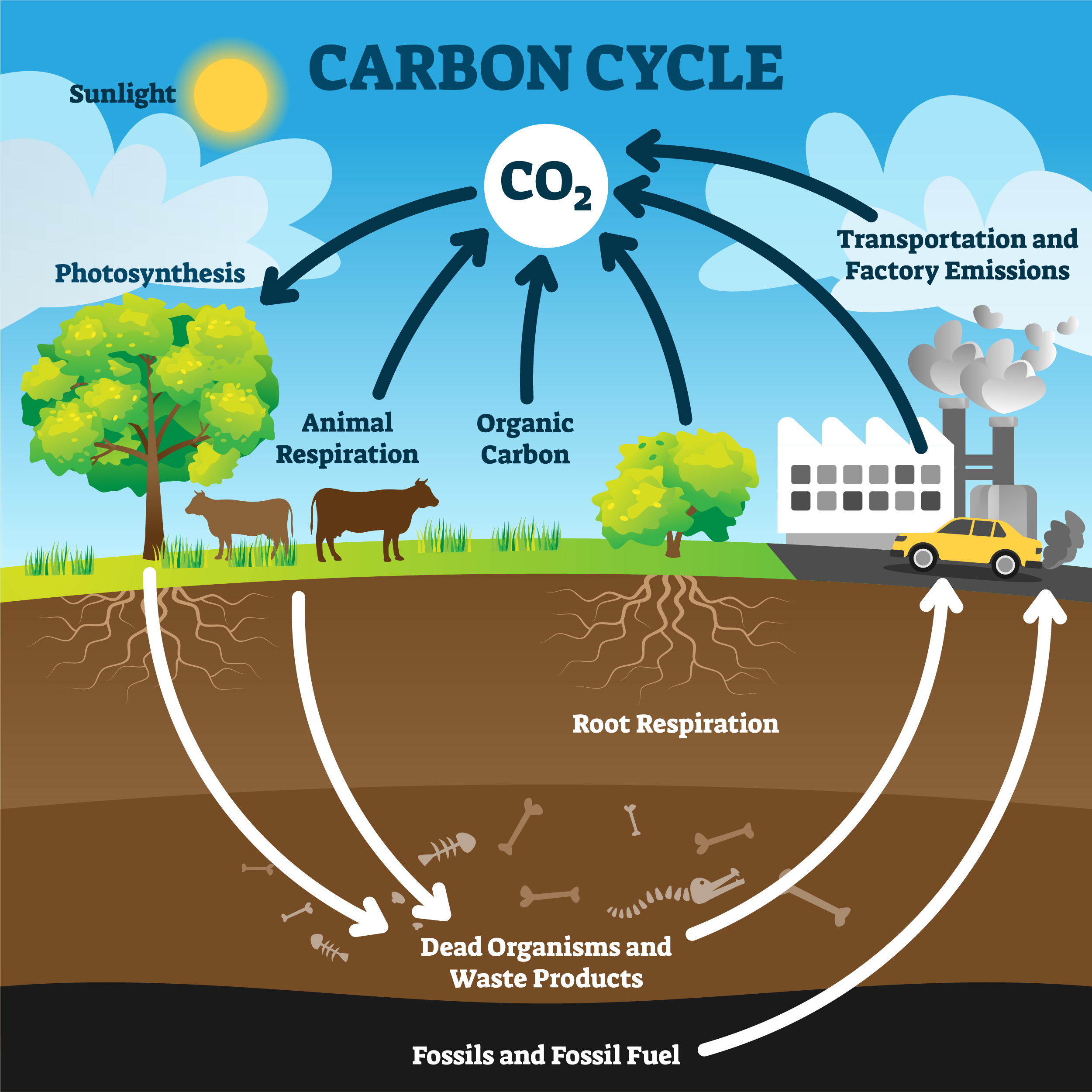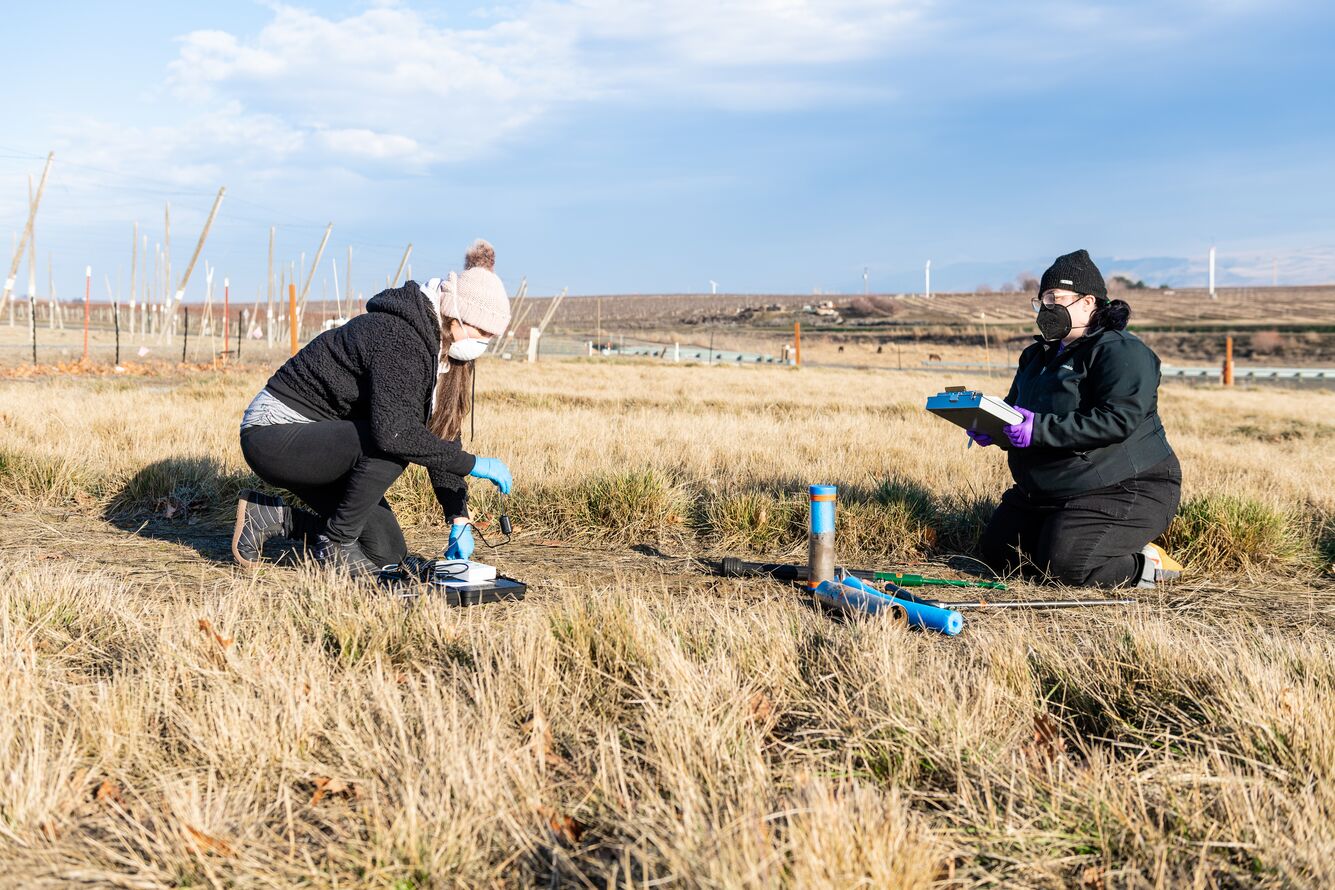Biogeochemical Transformations
What are biogeochemical transformations?
Biogeochemical transformations are natural pathways that mediate the flow of fundamental nutrients and chemical elements between living organisms and the environment, as well as the transformation of chemical compounds within the environment. These pathways involve multiple chemical, geological, and/or biological parts of an ecosystem. Chemical and geological systems are the nonliving, or abiotic, parts of the biosphere, whereas biological systems are the living, or biotic, parts of an ecosystem.
Ecosystems experience continuous recycling of elements that collectively support living systems. Understanding biogeochemical transformations is critical to our understanding of how the Earth stores energy and conserves matter, as well as how ecosystems function. This is important when identifying causes and solutions for climate change, as well as for examining, developing, and refining sustainable options and processes in our daily world.
Biogeochemical transformations occur in nearly every environment on Earth. They occur in the Earth’s crust, soils, water, on the sides of buildings, and even in tree leaves, for example. They involve elements such as carbon, nitrogen, iron, oxygen, sulfur, calcium, phosphorous, and many more.

Biogeochemical transformations in history
Research related to biogeochemical transformations became more prevalent in the 1960s and 1970s as researchers examined the cycling of elements in forests, fertilizer application in agriculture, and losses of chemical elements to stream water.
Biogeochemical studies have also examined the impacts of acid rain, nitrogen deposition, soil carbon storage, and pollution remediation. These studies have led to revelations regarding causes and solutions for climate change, as well as generally for processes of chemical flow in agricultural ecosystems and cities.
Across the world, biogeochemistry has become an important component of other fields of research, including geology, oceanography, soil and atmospheric science, Earth and environmental science, geomicrobiology, environmental chemistry, and ecology. Researchers study chemical elements, stable isotopes, biogeochemical cycles, and trace elements.
Some related research fields include carbon sequestration, environmental remediation, and environmental microbiology.
The importance of biogeochemical transformations
Biogeochemical transformations provide information about how ecosystems function and are critical to our understanding of how physical and chemical changes to the environment affect global sustainability.
Many biogeochemical transformations involve elements key to human and environmental health, such as carbon, oxygen, nitrogen, phosphorus, and sulfur.
Oxygen, nitrogen, and carbon cycles are what make life possible on Earth. While they are separate processes, they depend on one another. Carbon cycles from the atmosphere to living things and back to the atmosphere. The process involves photosynthesis, respiration, methane production, and decomposition. Through the oxygen cycle, oxygen flows through the atmosphere to the biosphere (parts of Earth where life exists) and lithosphere (rigid outer part of Earth containing crust and upper mantle) through processes such as photosynthesis and respiration. Together, these processes help sustain life. Through the process of photosynthesis, for example, plants absorb carbon dioxide before turning it into oxygen where it is consumed by animals and humans and then breathed back into the atmosphere as carbon dioxide. Carbon dioxide is released from the breakdown of organic materials that occurs during decomposition.
Microbial transformations play a critical role in the transformation of chemicals, such as metals and their compounds, hydrocarbons, pollutants, etc. For example, scientists have been able to clean up contaminated environments by taking advantage of the natural diversity of microbes, using them to break down toxic chemicals and compounds. They have also been important in the development and improvement of steroids, antibiotics, and pesticides, as well as in the natural development of plants. As part of a natural process through nitrogen fixation, microbes found on the nodules of legumes combine nitrogen with other elements to form compounds such as ammonia, which supports the development of the plant.
The phosphorus cycle involves the movement of phosphorus through the lithosphere, hydrosphere (all water environments on Earth’s surface), and biosphere in terrestrial and aquatic systems. This transformation occurs through weathering, leaching, and biological uptake and decomposition. Through weathering, rain can cause rocks to release phosphate ions, which are then distributed into the soil and bodies of water, ultimately supporting plant and microbial growth.
Sulfur also cycles through geological and biological processes, often involving the movement of sulfur between rocks, waterways, and living systems. Through weathering, sulfur is released from rocks and is absorbed by microbes and plants. In the wetland environment, sulfur is an important element because it is intertwined with the carbon, nitrogen, and iron cycles, and is what makes for the rotten egg smell that can permeate those environments. It is taken up as sulfate by plants and algae and is used to make two of the essential amino acids needed to make proteins.

The benefits of biogeochemical transformations
Through biochemical transformations, researchers can answer critical questions about chemical, physical, hydrologic, microbial, and atmospheric interactions that affect the mobility and transformation of critical nutrients, contaminants, aerosols, particles, and compounds. Climate change, plant growth, and water quality are some of the largest fields of research regarding biogeochemical transformations.
Activities affecting biogeochemical transformations
Physical and chemical changes brought about by human land practices can affect biogeochemical transformation processes at a local and global level. When these processes are disrupted, human health, water quality, food security, and biodiversity are threatened.
One of the greatest drivers in global climate change is the disruption of the carbon cycle. When fossil fuels are burned for energy, the reservoir of carbon bound in fossilized plant material is released as carbon dioxide, resulting in a growing concentration of atmospheric carbon. Additionally, forests represent a large carbon reservoir. When trees are harvested and not replanted at the same rate, carbon from those trees is released into the atmosphere.
Biogeochemical transformations within the hydrologic cycle are also affected by climate change. Global warming causes ice sheets at the poles to quickly melt. As a result of burning fossil fuels, nitrogen and sulfur are released into the atmosphere and can result in acid rain. Phosphorus and nitrogen cycles become imbalanced when fertilizers are spread on agricultural fields, causing high nutrient runoff and over-enrichment of minerals and nutrients in nearby streams, rivers, lakes, and bays.
Recent work in biogeochemical transformations
Research related to biogeochemical transformations relies on both laboratory and field data, as well as statistical modeling for information about ecological processes. In one recent study, researchers examined microbial communities in hyporheic zones to determine if nutrients can be fixed or respired during various environmental conditions.
Investigation into interactions between calcium and soil organic matter (SOM) are also improving our understanding of the molecular-level processes that influence nutrient cycling in alkaline soils. Field studies are being conducted to demonstrate the role of calcium-containing minerals in SOM stabilization. In the lab, researchers are exploring how SOM stabilization leads to nutrient availability.
Another research project examining biogeochemical transformations in sediment samples revealed that uranium attaches itself to organic matter rather than to inorganic minerals. This discovery shows that uranium may be more common and mobile than previously thought and implies the need for regulatory contamination limits, monitoring periods, and remediation strategies.
Biogeochemical transformations at Pacific Northwest National Laboratory
Pacific Northwest National Laboratory (PNNL) is a leader in biogeochemical transformations research with expertise in analytical capabilities, data visualization, and multiscale modeling. Researchers use the latest platforms and approaches to study the physiochemical effects of carbon and nutrient cycling, the interactions between metabolic pathways, and the dynamics of microbial communities. A variety of available instrumentation enhances this research. Capabilities include ultrahigh-resolution mass spectrometry, X-ray computed tomography, helium ion and scanning electron microscopy, Mössbauer spectroscopy, and X-ray photoelectron spectroscopy, among many others. As part of PNNL’s ongoing exploration in this area, researchers are also developing and improving models to predict and manage effects on both human and natural systems.
Partnering with scientists around the world, PNNL leads collaborative projects related to biogeochemical transformations. The Worldwide Hydrobiogeochemical Observation Network for Dynamic River Systems (WHONDRS) research consortium is working to improve resources and information about the hydrologic, biogeochemical, and microbial function within river corridors. Through the 1,000 Soils Research Campaign, the Environmental Molecular Sciences Laboratory (EMSL) at PNNL seeks to analyze soils from watersheds across the nation and form a database of standardized measurements using EMSL’s mass spectrometry, tomography, and soil chemistry capabilities. The intent is that the network and database will provide a more complete model of the roles that nutrient and contaminant cycling in watersheds play in ecosystem responses to disturbances or changes. Through the COMPASS Great Lakes Modeling study, researchers aim to enhance predictive understanding of freshwater coastal systems, including how they respond to climate warming, the conversion of different land use types, and other perturbations at watershed-to-regional scales.
